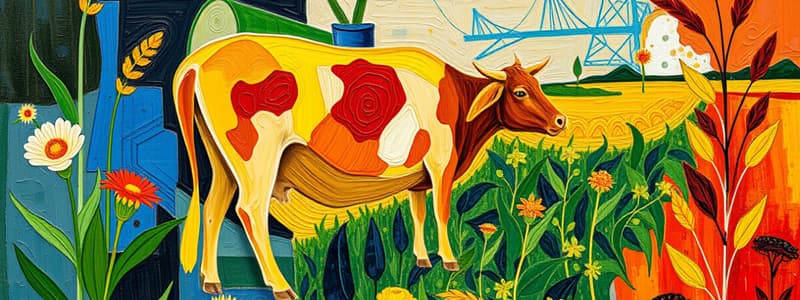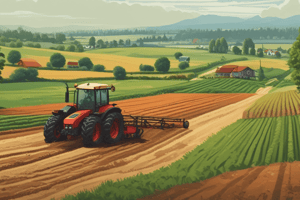Podcast
Questions and Answers
Which of the following is not an example of a leaf shape?
Which of the following is not an example of a leaf shape?
- Linear
- Ovate
- Rotate (correct)
- Lanceolate
Which of the following is correct?
Which of the following is correct?
- Rhizomes are examples of underground stem modifications (correct)
- Phyllocade are sub-aerial stem modifications
- Tubers are sub-aerial stem modifications (correct)
- Offsets are examples of aerial stem modifications
Rhizomes are sub-aerial modifications.
Rhizomes are sub-aerial modifications.
False (B)
What is the primary site of photosynthesis in a leaf?
What is the primary site of photosynthesis in a leaf?
What is the function of the cuticle in plants?
What is the function of the cuticle in plants?
What does the term 'stomata' refer to?
What does the term 'stomata' refer to?
Which vascular tissue moves food from the leaf to the rest of the plant?
Which vascular tissue moves food from the leaf to the rest of the plant?
What is the function of roots?
What is the function of roots?
What are root hairs and what is their function?
What are root hairs and what is their function?
Which type of root system arises from the radicle?
Which type of root system arises from the radicle?
What is the role of the root cap?
What is the role of the root cap?
The modified roots usually are swollen and assume different forms such as spindle shaped (e.g., _____).
The modified roots usually are swollen and assume different forms such as spindle shaped (e.g., _____).
Flashcards are hidden until you start studying
Study Notes
Leaf Functions
- Photosynthesis occurs in mesophyll cells, converting light energy into chemical energy.
- Transpiration is the process of water vapor loss from leaves, aiding in nutrient uptake from roots.
- Gas exchange involves absorbing carbon dioxide for respiration and releasing oxygen.
- Leaves can function in food storage by synthesizing secondary chemicals.
Leaf Structure
- Palisade Mesophyll consists of tightly packed cells that optimize light absorption.
- Spongy Mesophyll contains loosely arranged cells with air spaces to facilitate gas exchange.
- Stomata are pore-like openings that manage gas exchange (CO2 in, O2 out).
- Guard Cells are specialized cells that regulate stomata opening and closing by pumping potassium ions.
Tissues of the Leaf (Epidermis)
- Cuticle is a waxy layer that prevents water loss, regulates transpiration, and protects against pathogens and pests.
- Stomata predominantly located on the leaf underside facilitate gas exchange.
- Guard Cells control the size of stomata to maintain homeostasis within the leaf's internal environment.
Mesophyll Layer
- Palisade Parenchyma is where most photosynthesis occurs.
- Spongy Parenchyma contains chloroplasts; involved in both photosynthesis and gas exchange.
Vascular Bundles
- Vascular bundles (veins) in spongy mesophyll support nutrient transport.
- Phloem carries food from leaves to other plant parts.
- Xylem transports water and minerals from roots to leaves.
Roots Functions
- Roots anchor plants in soil, absorb water and nutrients, and store food.
- Some roots are adapted for propagation or reproduction.
Root Systems
- Tap Root and Fibrous Roots arise from the embryonic root (radicle).
- Adventitious Roots emerge from plant parts other than the radicle.
External Root Anatomy
- Root Cap: Thimble-shaped structure protecting the root tip from damage.
- Region of Cell Division: Houses apical meristem where active cell division occurs.
- Region of Elongation: Cells lengthen and widen, facilitating root growth.
- Region of Differentiation: Specialized cells develop, including root hairs, which increase absorption surface area.
Root Modifications
- Roots can be modified for food storage, taking forms like spindle-shaped (radish), top-shaped (beet), conelike (carrot), or indefinite shapes (sweet potatoes).
Studying That Suits You
Use AI to generate personalized quizzes and flashcards to suit your learning preferences.




